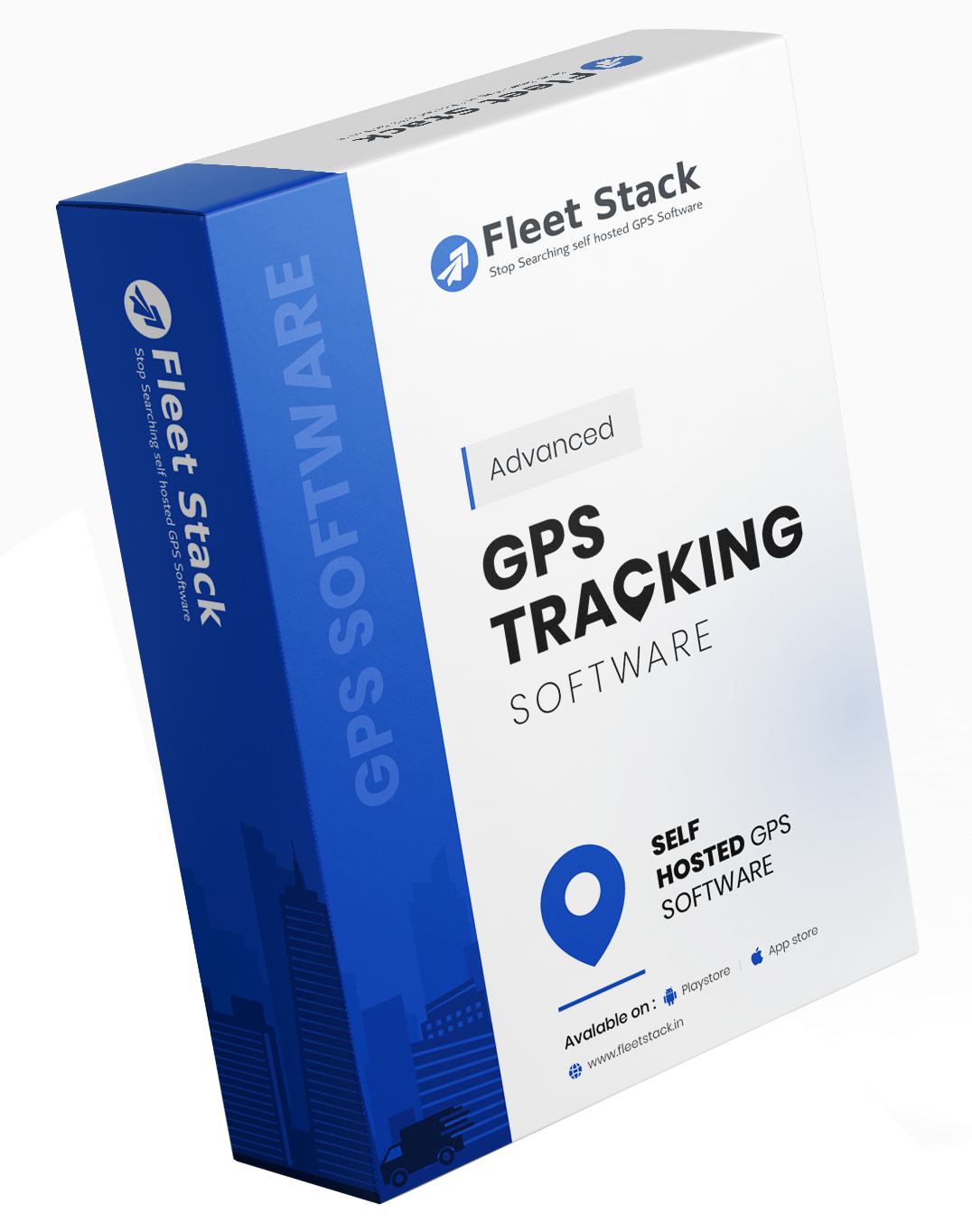
All About GPS Software
In the ever-evolving landscape of technology, Global Positioning System (GPS) software has emerged as a transformative tool for businesses across various industries.
GPS software is a sophisticated system that utilizes signals from satellites to determine the precise location of a device, vehicle, or person on Earth. The core functionality lies in the integration of satellite data to provide accurate real-time positioning information. This technology has far-reaching implications for businesses seeking to enhance efficiency and streamline operations.
GPS software is a transformative technology that has become an indispensable tool for businesses, especially in the realm of fleet management. Fleet Stack's advanced GPS software not only provides real-time tracking but also offers a comprehensive suite of features to enhance efficiency, reduce costs, and ensure the safety and security of valuable assets. As businesses continue to navigate the complexities of a dynamic market, embracing GPS software is a strategic move toward achieving operational excellence.
Start Free Trial
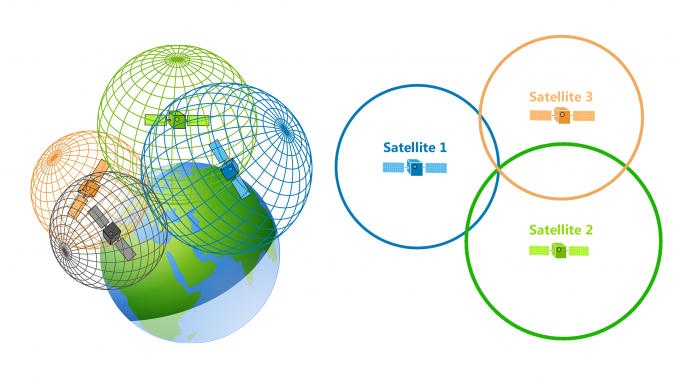
History
The Evolution of GPS Technology
The inception of GPS can be traced back to the early 1970s when the United States Department of Defense initiated the Navstar Global Positioning System project. The primary goal was to develop a satellite-based navigation system for military use. The first satellite in the GPS constellation, Navstar 1, was launched in 1978.
Selective Availability and Civilian Access
Initially, GPS was primarily a military asset, and civilian users faced intentional signal degradation known as Selective Availability. This changed in 2000 when the U.S. government, recognizing the potential civilian applications, discontinued Selective Availability, opening up the full precision of GPS for non-military users.
Collaborative Global Efforts
The GPS system is a result of international collaboration. The constellation includes satellites contributed by various countries, enhancing global coverage and accuracy. This collaborative effort has played a crucial role in establishing GPS as a universal navigation tool.
Commercialization and Integration
As GPS technology became more accessible, the private sector recognized its commercial potential. The 1990s witnessed the integration of GPS receivers into consumer devices, such as car navigation systems and handheld devices. This marked the beginning of GPS software finding its way into everyday applications.
Advancements in Accuracy and Reliability
Over the years, there have been significant advancements in GPS technology, improving accuracy and reliability. The introduction of differential GPS, which corrects for signal errors, enhanced precision in navigation, making GPS software indispensable in various industries.
Rise of Mobile GPS Applications
The proliferation of smartphones in the 21st century brought GPS capabilities to the masses. Mobile applications for navigation, mapping, and location-based services became widespread, transforming how individuals navigate and interact with their surroundings.
Expansion into Specialized Fields
Beyond traditional navigation, GPS software has expanded its reach into specialized fields. In agriculture, precision farming relies on GPS for optimizing crop management. Emergency services leverage GPS for swift and accurate responses, showcasing the adaptability of GPS across diverse domains.
Integration with Other Technologies
The synergy between GPS and other technologies, such as sensors and the Internet of Things (IoT), has further expanded its capabilities. This integration has given rise to smart navigation systems, real-time tracking solutions, and innovative applications in areas like augmented reality.
Essential Features of Advanced GPS Software
the given below feature will help you to identify the advancement of GPS Software
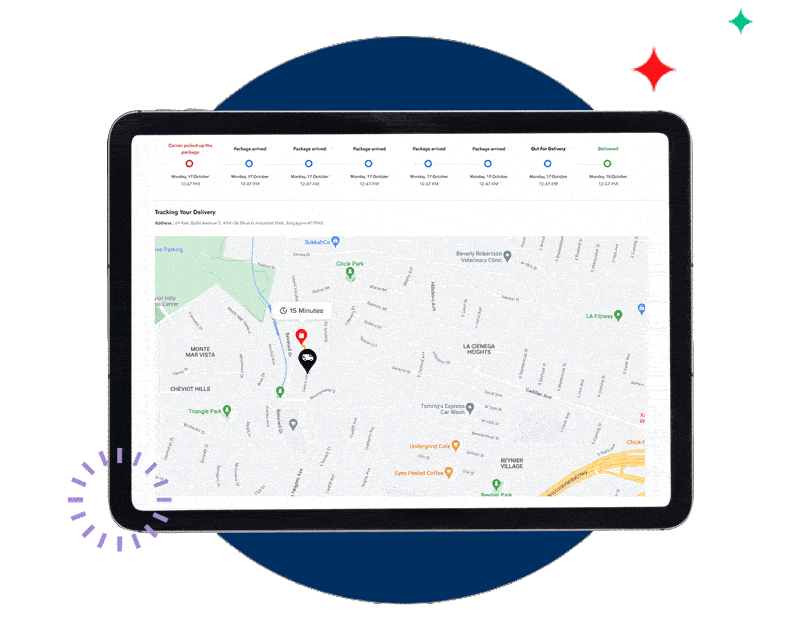
Real-Time Tracking
Live tracking, a quintessential aspect of GPS software, has transformed the way we monitor and manage assets, vehicles, and even individuals. This feature, offering real-time location updates, brings a new dimension to navigation, safety, and operational efficiency. Live tracking, a cornerstone feature of GPS software, empowers industries and individuals with real-time insights and unprecedented levels of control. As technology continues to advance, live tracking is poised to play an even more pivotal role in shaping the way we navigate, manage assets, and ensure safety in an interconnected world.

Geofencing
Geofencing, a cutting-edge technology within GPS software, is redefining the way we perceive and utilize spatial boundaries. This innovative feature holds immense potential across diverse industries, offering a dynamic and intelligent approach to location-based services.
Remark boundaries on map
Define virtual perimeters on maps for precise location demarcation.
Custom in/out Notify
Receive personalized notifications upon entry or exit from designated areas.
secure/danger zone
Safeguard specific regions with instant alerts for enhanced security.

History & Timeline
History & Timeline ensures precision in historical tracking. Users can delve into the archives and retrieve detailed historical data, helping them analyze routes, stops, and performance metrics.
Step by Step Tracking
Track every single step of your fleet with Advanced GPS Software solution.
Stopage Locations
Allow you to analyze all the points where vehicle stop not only location but also duration & time.
Vehicle Incident Analysis
Timeline is an advanced utility of GPS software that is a consolidated result of the vehicle driving

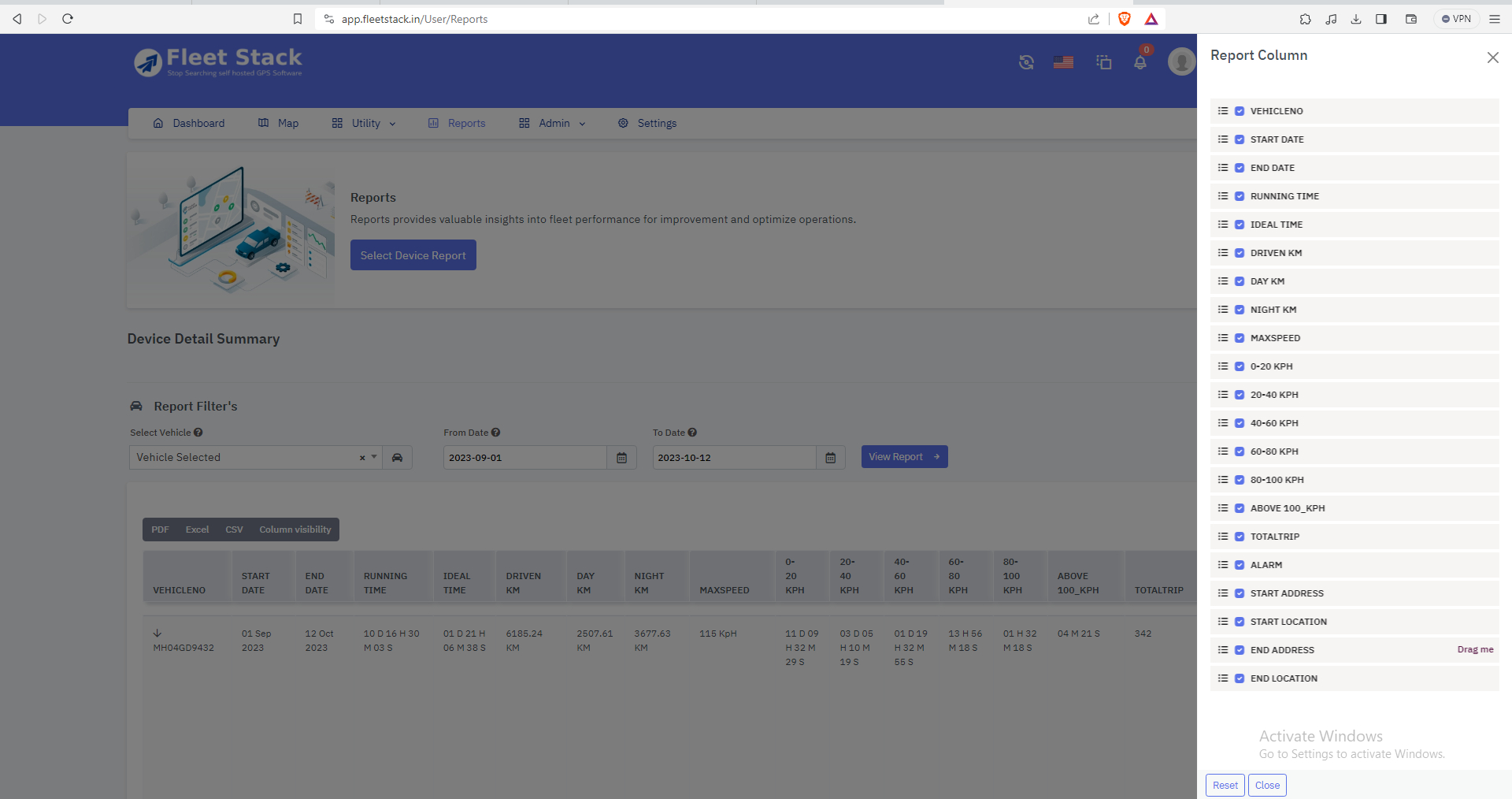
Advanced Reporting
Advanced Reporting feature is not a one-size-fits-all solution. It allows users to tailor analytics based on their unique business needs. Whether it's fuel consumption, driver behavior, or route efficiency, the power to customize is at your fingertips.
Custom Reports
Generate custom report to analyze fleet data as per the industrial use cases.
Report Scheduler
a software AI driven automation system automatically send vehicle report to your email.
Consolidate Data Analytics
a consolidated report can be generated to enhance vehicle performance based on data driven decision making.
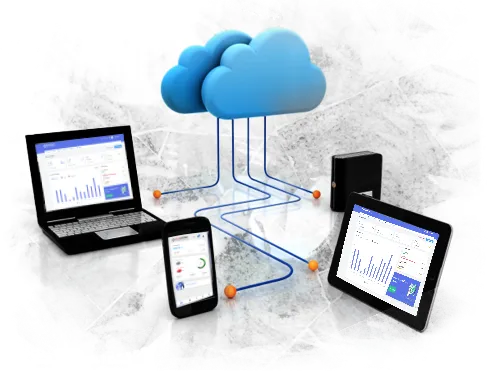
Platform Independent
Software solution should be deployable over multi OS like windows,ubuntu etc. that can we scale easily using latest auto scaling technology.
Windows Server
Cutting edge technology a software can be deployed over the IIS to distribution of the web application
Linux
linux is a good OS for deployment the deployment options for high performance applications.

Fuel & Other Sensors
Fuel & Other Sensors offer real-time visibility into fuel consumption. Monitor fuel levels, identify consumption patterns, and gain insights to make informed decisions that contribute to significant cost savings.
Fuel & temperature Sensor
Ensure optimal performance with real-time monitoring of both fuel levels and temperature, offering precise insights into your vehicle's conditions.
Container Lock
Enhance security with advanced container lock technology, safeguarding your valuable cargo during transit.
RFID Tag
Streamline logistics with RFID tagging, offering efficient tracking and management of goods throughout the supply chain.
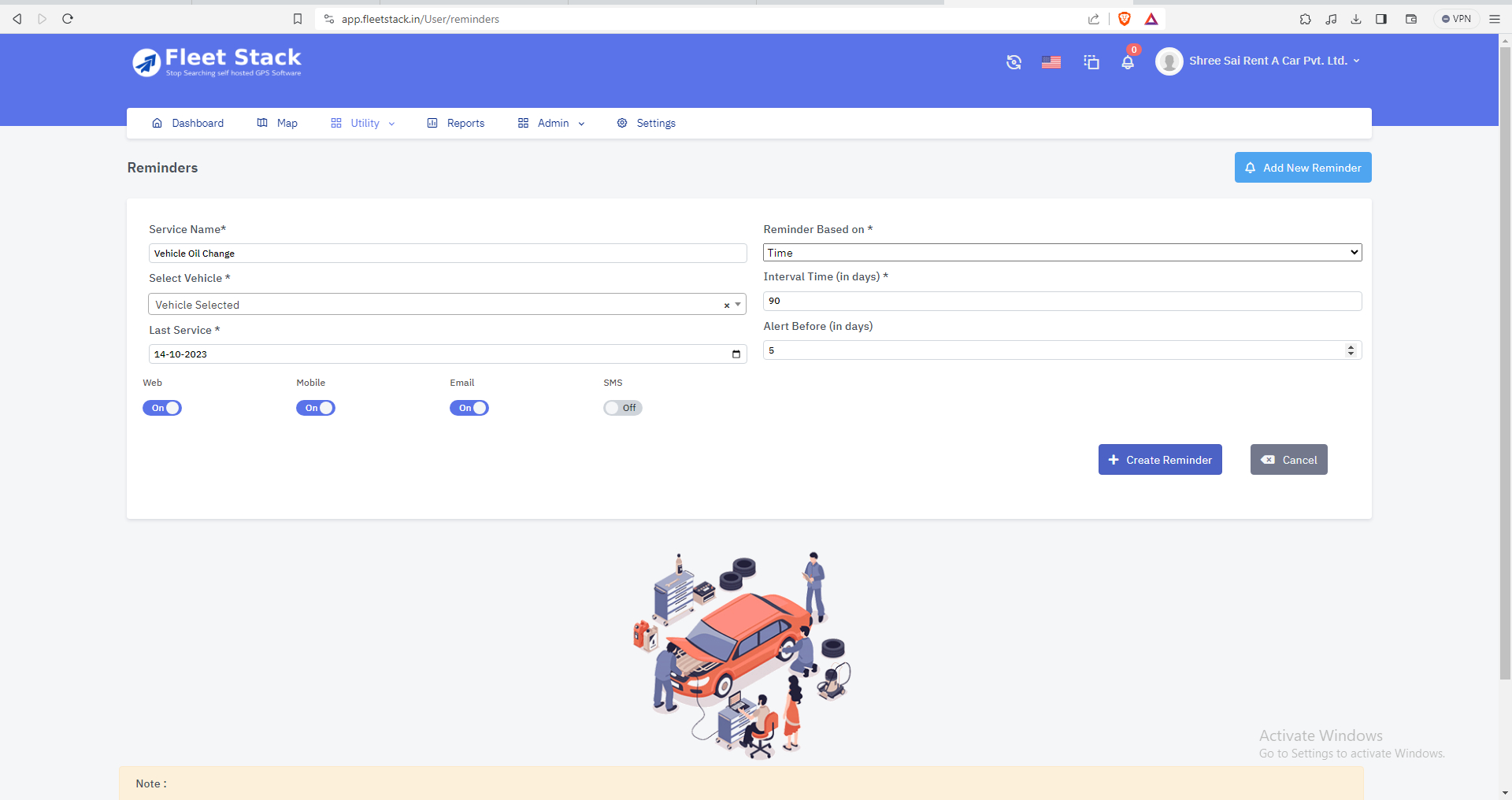
Maintenance Alerts
Maintenance Alerts go beyond conventional tracking. They leverage predictive analytics to detect potential maintenance issues before they escalate. Receive timely notifications, enabling proactive measures that prevent unexpected breakdowns.
Mileage-Based Reminders
Say goodbye to manual tracking. Fleet Stack's Maintenance Alerts use advanced algorithms to provide mileage-based reminders for routine maintenance tasks.
Downtime Reduction
Unplanned downtime can be a significant cost for any fleet. Fleet Stack's Maintenance Alerts are your preemptive strike against downtime.
Extended Vehicle Lifespan
Regular and proactive maintenance significantly contributes to the longevity of your vehicles. With Fleet Stack™, you can ensure that each vehicle in your fleet operates at its optimal capacity, maximizing its useful lifespan.
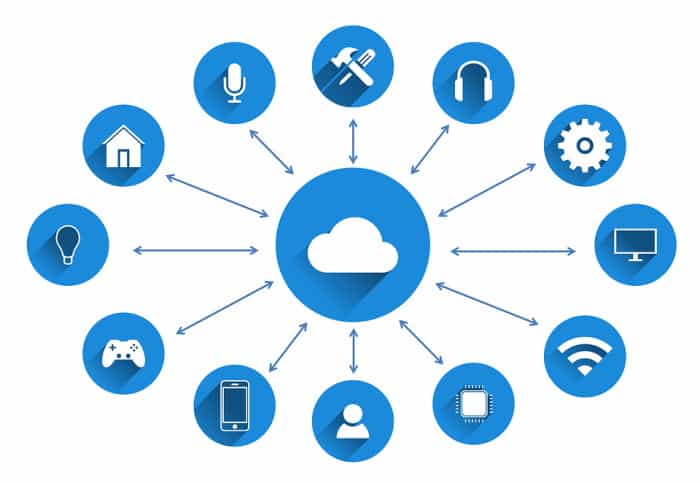
Integration with IoT Devices
IoT Devices orchestrates a seamless flow of real-time data. From vehicle diagnostics to environmental factors, this feature synthesizes information from diverse IoT devices, providing a comprehensive and accurate view of your fleet's operations.
OBD Devices
IoT Devices includes real-time diagnostics, alerting fleet managers to potential problems and enabling proactive maintenance to keep your fleet in top condition.
Custom IoT
Custom IoT solutions can be integrated with the GPS Software to enhance the data analytics & reporting
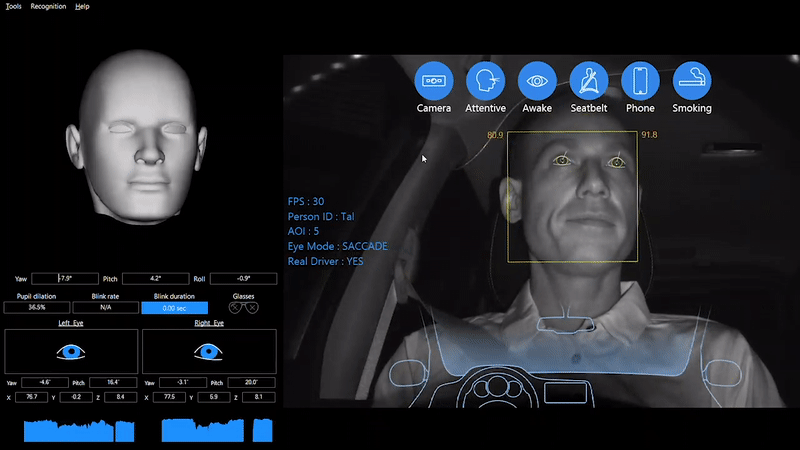
Driver Behavior Monitoring
Driver Behavior Monitoring goes beyond historical data; it's about real-time analysis. Gain instant insights into driver behavior, allowing for immediate intervention and coaching to ensure safe driving practices.
Driver Scoring
scoring driver based on their previous & real time driving behaviour analytics data like hash breaking, overspeeding etc.
Driver Identification
identify driver with the multiple ways may be rfid tag, fingerprint, QR code etc.
Real time alert
From harsh acceleration to abrupt braking, Fleet Stack's customization options enable fleet managers to set thresholds and receive alerts when predefined behavior parameters are breached.
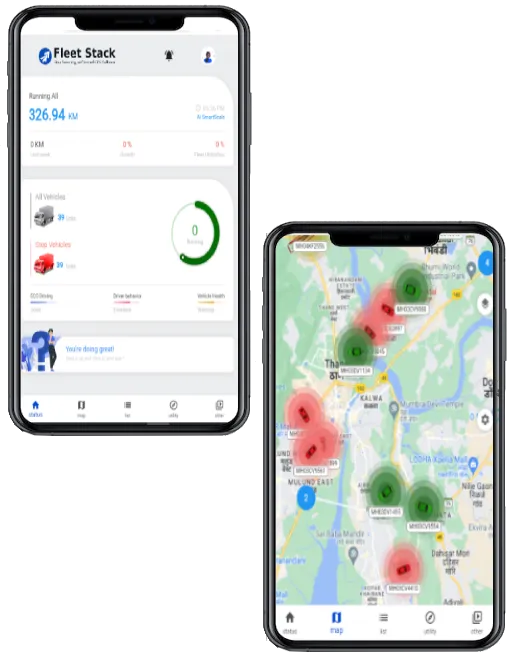
Mobile Accessibility
Mobile Accessibility, your fleet is never out of reach. Monitor real-time vehicle locations, statuses, and critical alerts directly from your mobile device. Stay connected to your fleet's activities whether you're in the office or on the move.
Android Application
Fleet Stack's Android app seamlessly integrates with Android devices, leveraging the platform's capabilities for a smooth user experience. The Android app is designed to work across a wide range of Android devices, providing flexibility for users who may have different device preferences.
IOS Application
Fleet Stack's iOS app is optimized to deliver a seamless experience on iPhones and iPads, leveraging the iOS platform's design principles and performance capabilities. Fleet Stack's iOS app is available on the App Store, ensuring easy accessibility and quick installation for iOS users.
Responsive UI/UX
Fleet Stack's responsive design transcends device limitations. Whether users access the software on a desktop, tablet, or smartphone, the UI/UX adapts dynamically. This ensures a consistent and enjoyable experience, fostering familiarity and reducing the learning curve across various platforms.
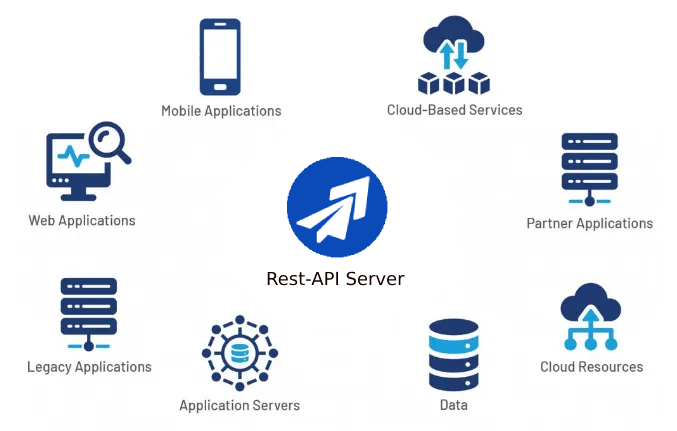
Rest API Integration
Fleet Stack's Rest API Integration facilitates a seamless flow of data. Whether it's vehicle locations, route histories, or real-time alerts, the API enables businesses to effortlessly exchange information between Fleet Stack™ and other systems, ensuring a synchronized and up-to-date dataset.
Data Synchronization
Keep your data in sync across platforms. Fleet Stack's Rest API Integration enables real-time synchronization of data, ensuring that changes made in one system are reflected seamlessly in the other, eliminating data discrepancies.
Third-Party Integrations
Fleet Stack's Rest API facilitates seamless integration with third-party applications and services. Whether it's connecting with logistics platforms, ERP systems, or other specialized tools, Fleet Stack™ ensures that your fleet management is part of a larger, interconnected ecosystem.
API Documentation
Swagger API Documentation goes beyond static documentation. It offers an interactive interface that allows developers to explore the API's capabilities directly within the documentation.
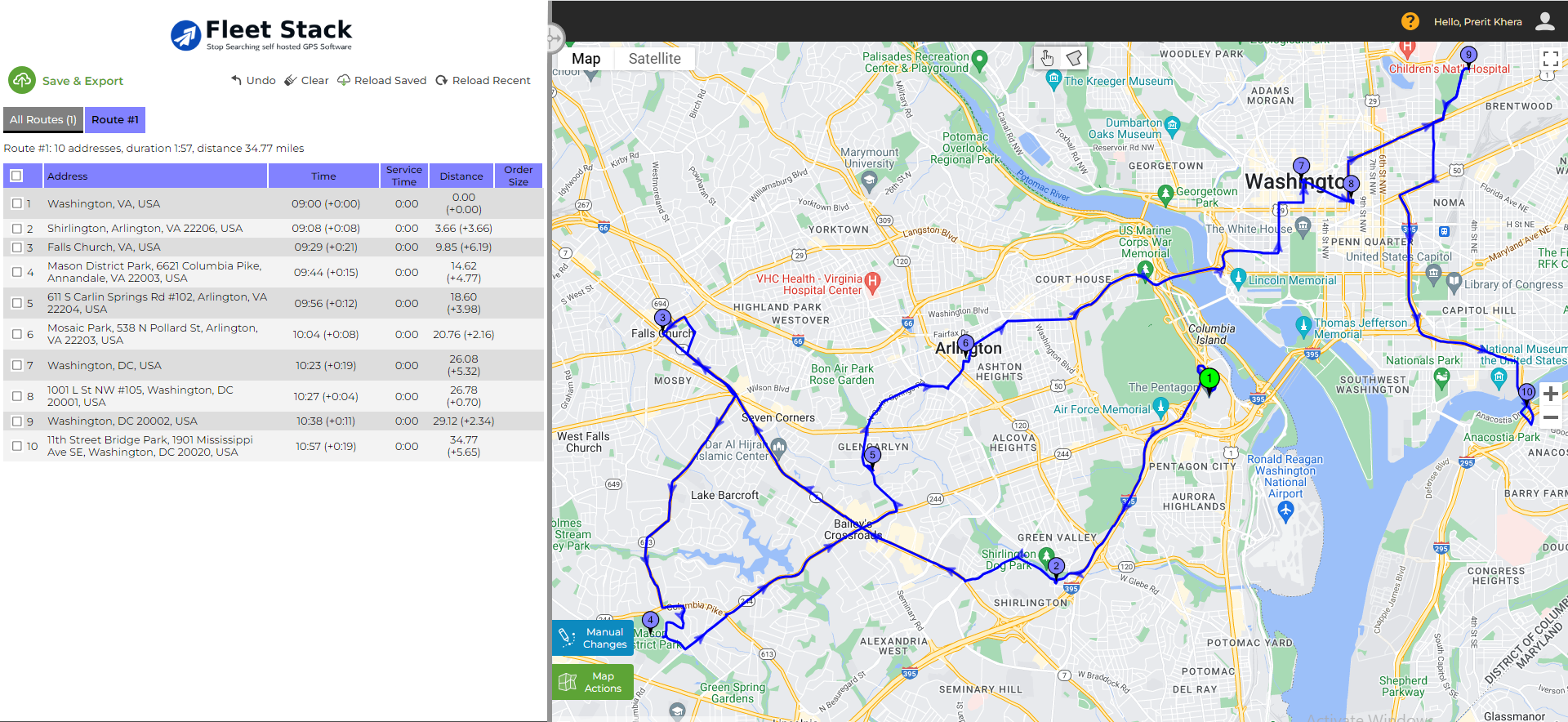
AI-Based Route Optimization
Route Optimization isn't just about mapping the shortest distance; it's about intelligently selecting paths that factor in traffic conditions, road closures, and real-time updates. This ensures that your fleet navigates efficiently, saving time and resources.
Real-Time Traffic Analysis
Fleet Stack's Route Optimization leverages real-time traffic data to analyze current conditions. By considering traffic patterns and potential delays, the system dynamically adjusts routes to minimize delays and keep your fleet on schedule.
Reduced Environmental Impact
Optimized routes aren't just good for your bottom line; they're also beneficial for the environment. Fleet Stack's Route Optimization minimizes unnecessary fuel consumption, contributing to a reduction in your fleet's carbon footprint and promoting environmentally responsible operations.
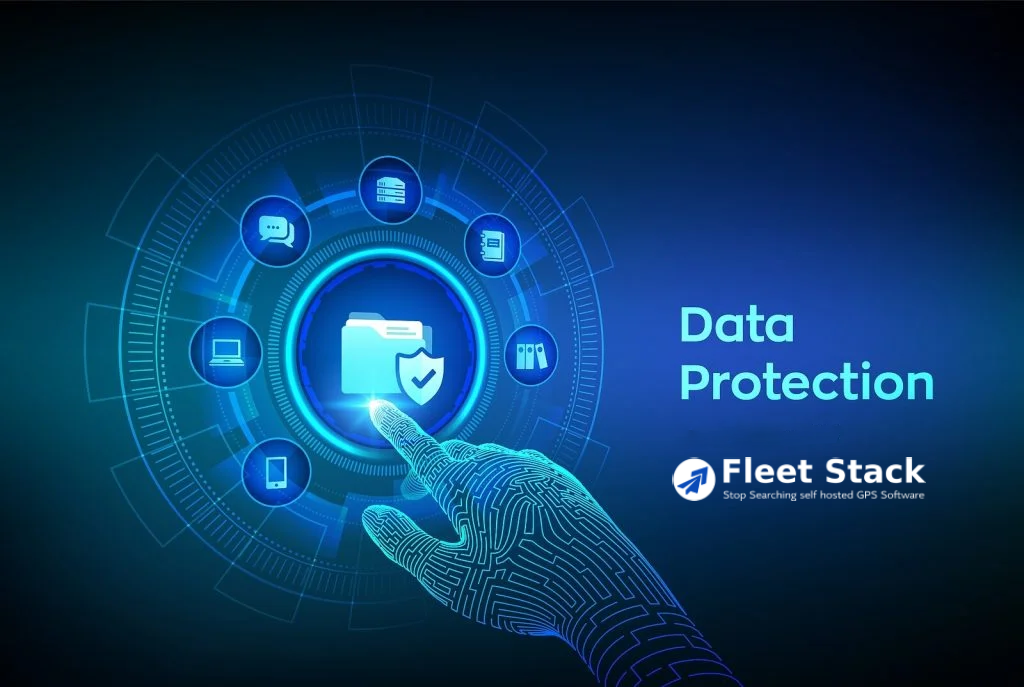
Security Features
In the era of digital connectivity, ensuring the security of fleet management software is paramount. Fleet Stack™ goes beyond the ordinary, integrating robust security features that protect your data, ensure secure access, and fortify your fleet management ecosystem against cyber threats.
Secure User Authentication
Fleet Stack's software security features include secure user authentication mechanisms.
End-to-End Encryption
Fleet Stack™ employs state-of-the-art end-to-end encryption to shield your data from unauthorized access.
Firewall Security for Network Defense
Fleet Stack™ stands as a digital fortress with the implementation of robust firewall security.

Scalability
In the dynamic landscape of fleet management, the ability to scale operations seamlessly is a decisive factor for success. Fleet Stack's GPS software is purpose-built for scalability, ensuring that it remains compatible and performs optimally as the number of vehicles in your fleet increases.
Cloud-Based Elasticity
As your fleet grows, the system dynamically adjusts to meet the increased computational demands, ensuring that you have a scalable solution without the need for significant infrastructure investments.
High Performance
Fleet Stack's GPS software emerges as a beacon of high performance. Engineered for speed, efficiency, and reliability, Fleet Stack™ ensures that your fleet operations are not just managed but optimized with precision and peak efficiency.
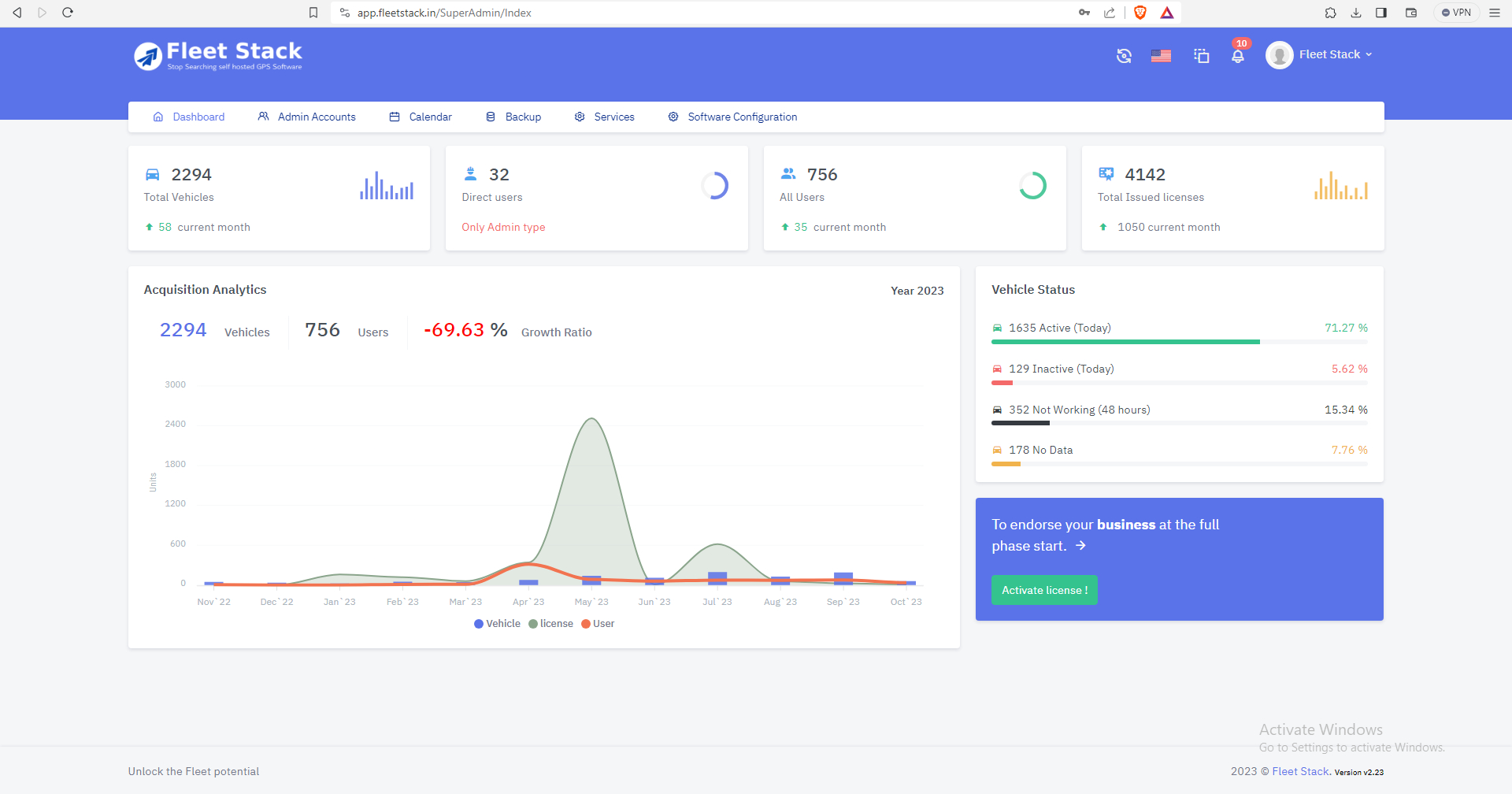
User-Friendly Interface
Fleet Stack's user-friendly interface begins with an intuitively designed dashboard. Information is presented in a clear and organized manner, allowing fleet managers to quickly grasp the status of their fleet at a glance. The dashboard serves as a centralized hub for real-time insights, key metrics, and actionable data.
UI/UX Design
Fleet Stack's UI/UX design is rooted in a thoughtful philosophy. Every element, from color choices to layout structure, is meticulously crafted to provide an interface.
Data Visualization Graph
Understanding complex fleet data is made simple through the visual representation enhances comprehension and decision-making.

Multi Language
Fleet Stack's Multi-Language feature offers a comprehensive array of language options. Users can choose their preferred language from a diverse selection, allowing them to engage with the software in a way that feels natural and comfortable.
Global Accessibility
Fleet managers and users across different regions can access and interact with the software in their native or preferred language.
Inclusive User Experience
Fleet managers from diverse linguistic backgrounds can engage with the software without language becoming a barrier, ensuring that everyone feels empowered and included in the fleet management process.


Customization
Fleet Stack™ understands that each fleet manager has unique priorities. The software offers flexible dashboard customization, enabling users to arrange and prioritize widgets, charts, and metrics according to their preferences.
Custom Development
Developers have the power to customize beyond limits with Fleet Stack's REST API. Whether it's tailoring reports, integrating with IoT devices, or creating a unique user experience, the API opens the door to limitless possibilities, ensuring that fleet managers have tools that precisely align with their requirements.
Self Deployment
The self-deployment process in Fleet Stack™ is designed for a quick start. The intuitive setup process ensures that fleet managers can get the system up and running without extensive delays, allowing them to start benefiting from the GPS software promptly.
 How GPS Software Works ?
How GPS Software Works ?
In the fast-paced world of today, staying ahead means leveraging technology to its fullest. One indispensable tool that has revolutionized the way we manage and monitor vehicles is GPS software. Let's delve into the intricacies of how GPS software works, exploring each essential component that ensures seamless and efficient operation.
GPS software is the backbone of modern vehicle tracking and management systems. It provides real-time location data, historical insights, and a plethora of features that empower fleet managers and vehicle owners to optimize operations, enhance security, and make informed decisions.
Key Components of GPS Software
Satellite Data Transmission
At the heart of GPS software is the use of satellite signals. A network of satellites orbiting the Earth emits signals that are received by GPS devices in vehicles. These signals contain crucial information that enables the determination of the vehicle's precise location.
GPS Device (Signal Receiver)
The GPS device, installed in each vehicle, acts as the signal receiver. It captures the signals from multiple satellites, allowing it to calculate the vehicle's exact location through a process known as triangulation. This location data is then prepared for transmission.

GPS Server (Vehicle Data Receiver)
Once the GPS device has determined the vehicle's location, it transmits this data to a central server or a cloud-based platform. The server acts as a centralized hub for receiving and storing data from multiple vehicles. It plays a pivotal role in data processing and management.
GPS Software User Interface
The end user, often a fleet manager or vehicle owner, interacts with the system through the GPS software user interface. This can be a web application, a mobile app, or specialized software. The user interface presents the data in an easily understandable format, such as maps, charts, and reports.
